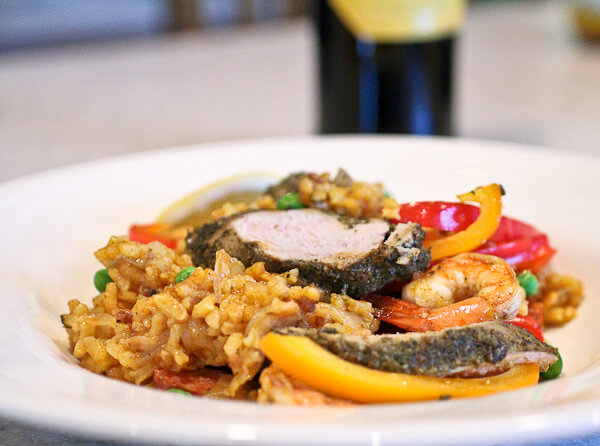
“Paella is a dish of poverty… If you have only a bit of leftover chicken and other odds and ends, you can make paella….” -Jose Puig, via Seductions of Rice, Jeffrey Alford and Naomi Duguid
I love this quote. This elasticity in the approach to paella was what led me to pick the recipe that I found for World Kitchen, believing that with so many different kinds of proteins (meats, sausages, seafood) included, people would be more comfortable using what was appropriate to their taste and lifestyle. However, somewhere along the way I forgot that paella is also all about the rice, and the recipe I chose had, frankly, lousy instructions for cooking the rice. That’s all on me, and I feel bad because Sunday morning when I looked at the recipe, I immediately realized that I did not feel good about the rice instructions. Unlike some of the other people participating in World Kitchen, I am obsessed lucky enough to have loads of other cookbooks to consult, so I was able to make what I think was an extremely successful fairly authentic paella. But for anyone who had trouble: I am so sorry! Next time I will do better!
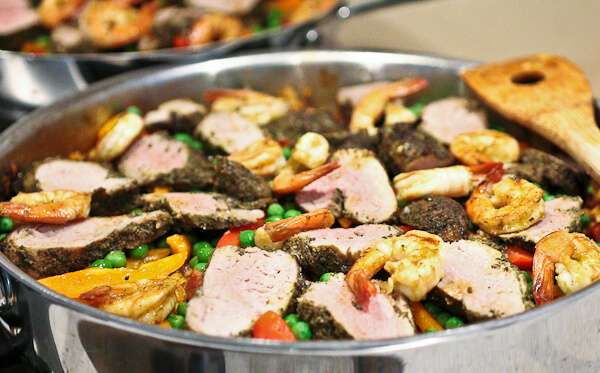
About the event itself. It was awesome. If you are able, I so hope that next time you can join in because it was tons of fun. Something about knowing we were all making the dish at the same time was really confidence-boosting (and I must say I got extra encouragement and instructions about the rice from Paula Wolfert (@soumak on Twitter), who was on twitter that morning, and World Kitchen participant Kelly (@ceallaigh on Twitter) of Kelly and Austin, who had had cooking classes in Spain). You know what, I put that last point in parantheses but I want you all to stop and think about that. I got advice on making paella the morning I made it from one of our country’s foremost authorities on Mediterranean cooking. And people wonder why I am on Twitter! Those of us who participated in World Kitchen shared pictures, we laughed over our errors, we celebrated the successes. And I am pretty sure we all ate really well. I didn’t hear anyone in my family complaining!


These 2 were especially not complaining, as they shamelessly begged during all of the pork, shrimp and sausage prep! Notice the complete concentration, as though by force of will alone they could get me to drop some tenderloin silver skin.
In honor of the successful day we had, to encourage you all to make some paella (better late than never) and to encourage you all to participate next time, I have 1 gram of 100% authentic awesome Spanish saffron to give away to one lucky reader! The saffron is being provided by our first World Kitchen sponsor, MySpiceSage.com. I will randomly choose a winner midnight the last night of April, Saturday, April 30 (that night, technically early morning of May 1). Here are the 2 ways you can win (leave me a comment for each please):
- Leave a comment on this blog telling me about your own experience making paella or whether you’d like to try to make it someday.
- Head on over to World Kitchen and leave a comment there telling us what dish or cuisine you’d like to see featured on World Kitchen (but leave me a comment here telling me you did so).
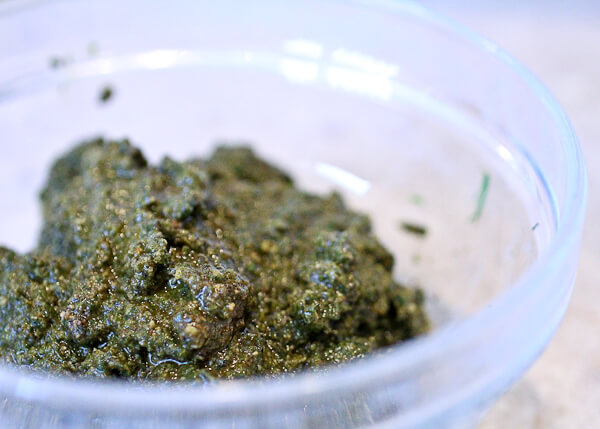 This marinade might be the best thing I have ever smelled. Ever.
This marinade might be the best thing I have ever smelled. Ever.
A few notes about the rice. Short grained rice is what should be used for traditional Spanish paella. We had people make it with long grain rice (I don’t blame them given the instructions they had!) and I personally have no problem with that. But if you want to make authentic Spanish paella and use short grain rice, here are the things that I learned (and which I believe need to be emphasized to an American cook, because we have different instincts): First, use a Calasparra rice from Spain if possible (many say Bomba is the best but I have heard some disagree), but failing that find a Spanish short grain rice, or, in a pinch, use a good Italian arborio (which was what I had to do). These short grain rices are used (unlike, for example, a Japanese style short grain rice) because of their awesome ability to absorb a lot of liquid. The Bomba in particular absorbs a ton. So the first thing you need to know is that there is no magic amount of liquid for the rice. Whatever you think you know about rice to water ratios, throw it out the window (and if you see a recipe claiming a 1:2 ratio will do it, find a new recipe!). Instead you are going to watch the pan and add liquid as it is needed, much like a risotto.
Second, again much like a risotto, the liquid you add should be simmering. Third, do not rinse or soak the rice. Fourth, you may see recipes that call for boiling the initial liquid before adding the rice and you may see some which call for roasting the rice first. As far as I can tell this is regional and/or depends on whether you have access to a second flame or burner (remember that paella was traditionally cooked over a single open fire). I chose to roast the rice first, but made sure that my liquid was simmering when I added it to the pan.
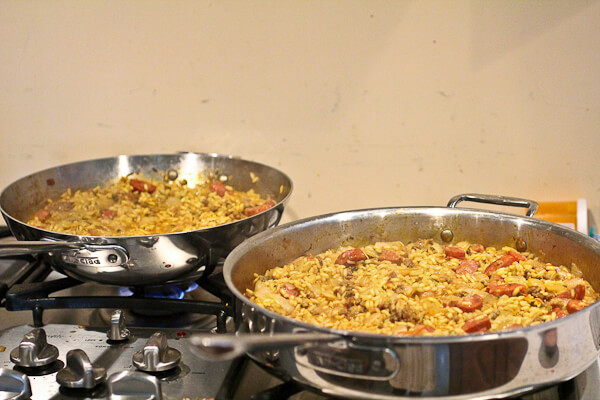
Fifth, and this one really threw me, do not cover the rice while it is cooking. And do not stir. Instead, what you do (and this really did work), is first cook the rice at a slow boil or vigorous simmer, shaking the pan to prevent the rice from sticking. Then, you will reduce the heat further and further, but always maintaining at least a very gentle simmer, adding liquid as needed and shaking occasionally. The rice will cook in about 25 minutes or so. Prepare the maximum amount of liquid and use it as needed (you may have a bit left over–better than not having enough). Keep in mind that after you turn the heat off, some liquid will still absorb into the rice as you let the pan sit for 5-10 minutes. This will not be as creamy as a risotto, but nor should the rice be light and fluffy.
One final note before beginning: this recipe is huge because the master recipe was huge. It would be easy to cut in half; I did not because I was working with a large package of frozen fresh Spanish chorizo and I did not want to waste it. Ergo, the bigger recipe got made. Just cut in half if you prefer.
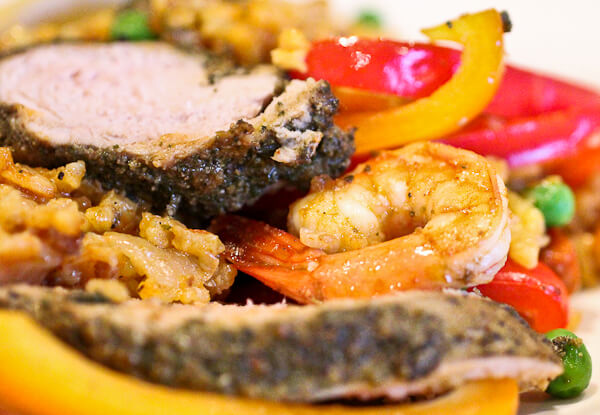
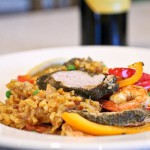
- 4 cups arborio rice if you use a Spanish short grain rice, which is preferable, heat several cups extra liquid
- 1 1/2 cups bottled clam juice
- 10 1/2 cups chicken stock or chicken stock and water I ran out of chicken stock after about 6 cups--the water worked fine
- 2 lbs loose raw Spanish chorizo
- 1 lb cooked and/or cured Spanish chorizo skin removed
- 4 large onions chopped
- 1 head garlic minced, divided
- 6 T chopped parsley divided (I had to sub cilantro)
- 4 T chopped fresh thyme leaves
- 6 T chopped fresh oregano leaves divided
- 1 heaping T coriander seeds
- 1 heaping T black peppercorns
- 10 T extra virgin olive oil divided
- 1 T paprika not smoked
- 1 t smoked Spanish paprika
- 1/2 lb tomatoes cut into wedges (if off season without frozen, use half can of drained canned chopped tomatoes)
- 2 pork tenderloins silver skin cut off
- 2 sweet bell peppers thinly sliced
- 10 oz bag frozen peas defrosted but cold (so just rinse with water and drain)
- 1/2 lb - 1 1/2 lbs shrimp I only had 1/2 lb but would cheerfully have used more
- 2 lemons or limes sliced into wedges
- 1 t saffron threads
- 1/2 cup red wine preferably a dry Spanish rioja, divided
- 1 t red wine vinegar
-
First prepare the marinade, by placing 1/4 cup each of the fresh herbs into a food processor with half of the minced garlic. Grind the coriander and black pepper and add it to the herbs. Add 2 tablespoons of the red wine and 1 teaspoon of the vinegar to the herbs. Add the paprika and begin to process. Add 1/4 cup of the oil, as a slow drizzle into the food processor. Scrape the sides as needed, until you have a coarse paste. Set aside 3 tablespoons of the paste and smear the rest all over the pork tenderloin. Place in a bag or covered container and chill to marinate, at least 1 hour, longer is preferable (mine marinated about 5 hours).
-
About 1 1/2 hours before dinner, heat up 2 large skillets (I used a 14 inch flat, deep skillet and a sloped, wok-like pan--they both worked). Heat 2 tablespoons of the olive oil in each of the pans. When it is hot, add the onions with a pinch of salt (divided between the 2 pans) and cook, stirring, for 5 minutes, until softened and translucent. From here on out the directions should all be divided in half between the 2 pans.
-
While the onions are cooking, place the clam juice and chicken stock (and water if using) in a sauce pan on medium low heat. Add the saffron and leave to slowly heat up. Once it boils reduce the heat to maintain a bare simmer.
-
Add the loose Spanish chorizo to the onions and cooking, stirring and breaking the sausage up, until the sausage is near browned. Add the remaining garlic and cooked or cured Spanish chorizo to the onions. Also add the remaining red wine, the smoked paprika and tomatoes and cook for 5 minutes, stirring, until the wine cooks off. Add the remaining fresh parsley and oregano, as well as the reserved marinade.
-
Preheat the oven to 425 F and place a cast iron skillet large enough for 2 pork tenderloins in the oven to heat up as well.
-
The onion pans can be taken off the heat at this point to get the timing on everything right. The rice does not need to be added immediately.
-
When the oven is heated, drizzle 2 tablespoons of the olive oil into the cast iron skillet and immediately add the pork tenderloins. Return them to the oven and roast until they are 145 F.
-
In the meantime, heat the pans on the stove on high heat about 30-40 minutes before dinner time. When they are hot, sprinkle the rice into the pans. Cook, stirring the rice, on high heat until the grains are translucent. Add liquid to the rice at a 1:2 ratio at this point (so for 4 cups of rice, add 8 cups of the heated liquid). Reduce the heat to medium and shake the pan to prevent sticking. Let it cook like this for 5 minutes, shaking the pan occasionally.
-
After 5 minutes, add more liquid, maybe 2 cups total, and reduce the heat to medium low. Shake the pan again, occasionally, and let cook for 10 minutes (if it is boiling too hard, reduce the heat further). Keep watching for more liquid to be added; my experience was that there should be little pockets of liquid bubbling up--if there is not, add a little more liquid to the pan (but add it by the 1/4-cup or so at this point). Then reduce the heat as low as you can to maintain a very gentle simmer, for the final 10 minutes, again adding liquid as needed and shaking the pan. Toward the very end the rice may not shake quite as well, but it never stuck for me. When you have 5 minutes to go, lay the pepper slices out decoratively on the pans. Sprinkle the peas over that. They will steam the last 5 minutes.
-
In the meantime, remove the pork and let it rest on a cutting board. Have the shrimp ready to cook. When the pork has rested for 10 minutes, slice it into rounds.
-
When the paella is finished (test a small bite and be sure the top rice is cooked), turn off the heat. Lay the pork slices over the top of the peas and peppers.
-
Using the cast iron skillet which is full of yummy pork goodness and marinade as well, sear the shrimp quickly on the stovetop. Add to the top of the pans.
-
Serve the paella after it has rested 5-10 minutes after the heat is turned off.
Shout-outs to the cookbooks that helped me: Paula Wolfert’s The Slow Mediterranean Kitchen; Seductions of Rice by Jeffrey Alford and Naomi Duguid (the best all purpose rice book you can own); and The New Spanish Table by Anya vom Bremzen.
Wow, yours looks fantastic! I love this post too, very eloquent. I wish I had known all this about the rice before cooking…that was the ONLY thing wrong with mine. I was really pleased overall with the dish but the rice was nowhere near cooked 🙁 The boys loved it despite the rice though, and cleaned their plates. Regardless, it was fun to make and I enjoyed the experience. Can’t wait for next month! I liked the challenge 🙂
P.S. Please don’t include me in the giveaway, as they’re sending me some for participating in World Kitchen 🙂
This post is amazing! Thanks for sharing. It was so much fun participating in the World Kitchen event!
I would love to try making Paella. I haven’t yet because I always thought you needed a special pan. 🙂
I commented on the World Kitchen site that I would love to learn how to make a Tagine. {Does that dish need a special pan too?}
Hey Amanda – Fellow World Kitchen host here – hop over to my blog on Moroccan food http://www.marocmama.com I’ve got loads of tajines all can be made without the actual tajine pot 😉
Laura – lovely pictures!! I’m amazed at your ability to cook, tweet and photograph you are a multi-tasking phenom!!
I love paella I bought a pan just to make it every week!!
I would like to see Milenese!
Aside from the heavenly taste and aroma of Paella, it satisfies my schizophrenic food moments…meat? seafood? seafood? meat? I get the best of these culinary delights…clams, shrimp, chicken, sausage…a healthy dose of vegetables- pea & tomatoes- over a bed of velvety, saffron rice. I can’t pass it up on a menu. I’ve had it with filet mignon and lobster and although this is an elegant treat, it is never better than the original “peasant” recipe served in the center of my table with a bottle of fruity sangria to wash it down.
I haven’t ever tried making paella but I’d love to give it a try! Great post!
i have never made pallea – in part because of the cost of the saffron – but would love to give it a try. is there an all vegetable version?
I’ve never seen one but why not?
have left a comment on world kitchen saying i would like to see variations on “spice” cookies
Who has paella? I hear someone cook it, where . . . . . I am ready to come over with my big spoon . . . . Look delicious. I LOVE paella.
All kinds of deliciousness here!
What kind of a dog do you have?? Precious!!
Sorry never answered this, Chesapeake Bay Retrievers. 🙂
Wow! This looks delicious 🙂 I’ve never had this before, but now would love to try!
Paella and all its odds and ends sounds right up my alley! I’ve never made it before, but I’d sure like to try!
I commented at World Kitchen!
I have never been brave enough to try making paella, but I would love to try!
went to World Kitchen and left a comment
We actually have not tried to make it, but we do love paella, especially with lots of fresh seafood in it! Great post!